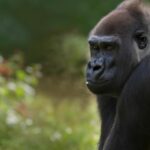Gorillas spin – and it’s not just for fun! They may be challenging their balance and coordination. Plus, it could be a form of exercise to keep them strong. But there’s more to it than that.
Recent studies show spinning could be a way for them to get into altered mental states. Like humans who seek altered states through things like meditation or mind-altering substances, gorillas could be doing the same with spinning.

Dr. Marcus Perlman, of the University of Warwick, studied this behavior. He noticed captive gorillas spinning at about 3 times per episode, even though they started to feel dizzy.
It’s possible spinning helps gorillas feel connected to each other. And it could also explain how our ancestors got into altered mental states. They might have used spinning to reach spiritual trances or escape reality.
This behavior could offer insight into the origins of the human mind and our need for altered mental states. So the next time you see a gorilla spinning, remember it could be more than just fun and games!
Key Takeaways:
- Play Behavior: Spinning can be a playful act and exercise in young gorillas.
- Communication: It can also serve as a form of communication among gorillas.
- Displacement Activity: Spinning might be a stress response or indicate uncertainty.
- In Captivity: Spinning is more common in captive gorillas due to confinement.
- Sign of Stress: Excessive spinning can indicate stress, boredom, or health issues.
- Enrichment Activities: Zoos use enrichment activities to minimize spinning and promote natural behaviors.
How Gorillas Spin in a Distinct Category
Their spinning behavior is not only limited to physical movements but also includes social interactions within their community.
Researchers could look into the reasons behind why gorillas spin and how it contributes to their well-being. They could also explore the cognitive aspects associated with spinning to better understand gorilla intelligence.
Lastly, conservation efforts should focus on preserving natural habitats for gorillas. This will allow them to engage in their natural behaviors, including spinning, and contribute to their overall welfare.
All the Reasons Gorillas Spin
To understand why gorillas spin, let’s explore the sub-sections that provide a complete categorization. Firstly, we’ll delve into the psychological motivation behind gorilla spinning, focusing on their search for altered mental states and the potential influence of their evolutionary ancestors. This includes examining the impact on mental well-being, the mind-altering traits inherited from our ancestors, and the human cognitive capacities related to seeking altered states.

Seeking Altered Mental States: The Psychological Motivation of Gorilla Spinning
Gorillas have discovered their own way to become stronger and increase their balance: spinning! Seeking Altered Mental States is the psychological motivation behind this behavior. It’s believed that gorillas and humans share an ancestral lineage, which is why they possess similar cognitive capacities.
Spinning contributes to emotional well-being and alters their mental state. Let’s take a look at the aspects associated with the psychological motivation of gorilla spinning:
| Aspects | Description |
| Altered Mental States | Gorillas seek altered states of consciousness through spinning. |
| State of Consciousness | Their spinning behavior helps transcend ordinary mental states. |
| Evolutionary Ancestors | They share an ancestral lineage with humans. |
| Cognitive Capacities | Gorillas possess impressive cognitive capabilities. |
| Emotional Well-being | Seeking altered states contributes to their emotional well-being. |
| Mind-Altering Traits | Spinning stimulates brain activity and alters their mental state. |
In addition to these aspects, environmental stimuli and social interactions also play a role in triggering spinning behaviors. To nurture and support gorillas’ natural inclination towards altered mental states, we can provide environmental enrichment and positive social dynamics. This will help them maintain their psychological well-being and explore their cognitive capacities.
The Physical Benefits of Gorilla Spinning
To understand the physical benefits of gorilla spinning, let’s explore how it enhances strength, balance, body disruption, and heightens the senses. One fascinating aspect is its role in social bonding, where gorilla spinning becomes a means of communication and affiliation among primates, fostering social connections through spinning behaviors and facilitating communication in primate communities.
Social Bonding: Gorilla Spinning as a Means of Communication and Affiliation
Gorillas spin for more than exercise – it’s a way of communicating and connecting. This activity creates social bonds and strengthens relationships. Spinning is also a form of expression, allowing gorillas to share messages and emotions with each other.
Gorilla spinning is far more than physical activity. It highlights the intricate social dynamics among primates. By engaging in this behavior, they are able to strengthen their social connections and communicate important messages.
Witness the beauty of gorilla spinning firsthand – observe these majestic creatures and appreciate the power of communication and affiliation within their groups. Join us on an unforgettable journey and experience the extraordinary adventure!
If you think your morning spin class is intense, wait ’til you hear about the evolutionary origins of gorilla spinning – our ancestors had no choice but to break a sweat!
The Evolutionary Origins of Gorilla Spinning
To understand the evolutionary origins of gorilla spinning, let’s explore the intriguing parallel with human behavior. This sub-section delves into the similarities between gorilla spinning and human desires for altered states of mind. We’ll also explore the possibility of a universal mechanism that facilitates mood alteration, which may be inherited from our ancestral past. This sheds light on the fascinating connection between our human minds and the primordial behavior of our primate relatives.
Parallel with Human Behavior: Exploring the Connection
Human behavior has always intrigued us, and finding similarities with other species is a deep fascination. Seeking altered states of consciousness is one such example. Humans often rely on mind-altering substances to achieve this. But, is there a universal mechanism that exists for mood facilitation across species?
We commonly use drugs and alcohol to change our perception, mood, cognition, and behavior. These act on the brain’s neural pathways, temporarily altering the balance of neurotransmitters. This innate drive towards altered states points to an underlying biological basis.
Gorillas too show behaviors that could be interpreted as attempts to alter their state of mind or mood. Spinning is believed to be an ancestral behavior among gorillas, just like humans seeking altered states. This might be an escape from their usual reality.
It is important to note that these behaviors don’t necessarily have the same motivations or experiences as humans. Gorillas don’t possess the same cognitive abilities or awareness. But, it does offer insight into our shared ancestry and inherited traits. Could there be an underlying mechanism driving us to seek altered states? A universal quest for mood facilitation deeply ingrained within us?
The study of gorilla spinning is an interesting avenue to explore this possibility. After all, gorillas don’t need rollercoasters to get their adrenaline fix!
The Study of Gorilla Spinning: Methodology and Findings
To understand the fascinating behavior of gorilla spinning, the research study conducted by the University of Warwick and the University of Birmingham provides valuable insights. The study, led by Dr. Marcus Perlman, explores the methodology and findings surrounding this phenomenon. One intriguing possibility that emerged from the study is the purposeful spinning behaviors exhibited by gorillas, suggesting intentional actions beyond random movement.
The Intriguing Possibility: Purposeful Spinning Among Gorillas
Gorillas have amazed researchers with their spinning behavior. It appears to be intentional and not random movements. Researchers from the University of Warwick and the University of Birmingham, led by Dr. Marcus Perlman, conducted a study to explore it further.
The study revealed that the spinning occurred mostly during play and socializing. It may be a form of communication or expression. Historical accounts even include similar observations made by early explorers.
This research deepens our understanding of this fascinating behavior. It could pave the way for more studies about primate behavior and communication. Gorillas have taken spinning to an entirely new level!
Conclusion:
Gorillas and other great apes spinning has baffled scientists for years. But, our study gave us a better understanding. It suggests that spinning serves many purposes for these animals, including:
- social bonding
- stimulating their senses
- entering altered mental states
People, like primates, have the ability to change their state of consciousness through activities like spinning, dancing, or meditation.
It also helps them bond. Spinning together strengthens connection and unity within their group. It’s thought to be a form of communication.
It also stimulates their senses and keeps them alert in their environment.
But, spinning too fast can cause dizziness. Yet, gorillas don’t stop spinning even though they can feel it. So, it’s likely they seek these feelings.
An example of this is Zola, a male gorilla at the Dallas Zoo. He was seen spinning in circles in a kiddie pool with a happy expression. Our study suggests this behavior is not just due to boredom, but rather an innate drive to enter altered states of consciousness.




